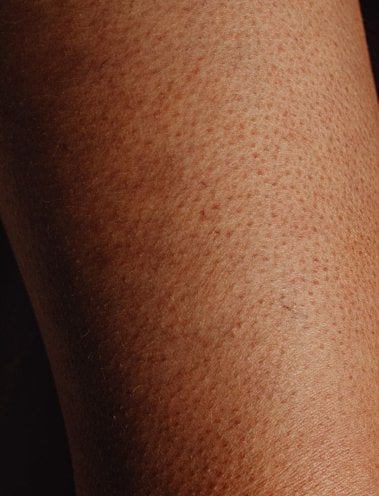Keratosis Pilaris: Everything You Need to Know

According to the
While this condition is harmless, it can sometimes feel itchy and uncomfortable. And if it’s getting in the way of your pursuit for smooth skin, there are methods to treat it. Here’s everything you should know.

What is keratosis pilaris?
According to the
“It can lead to roughness or bumpiness of the skin but is often without (other) symptoms.” says Dr Marisa Garshick, NYC-based board-certified dermatologist.
She adds: “If the skin is irritated, it may be itchy or painful. Typically, it appears as 1-2 mm-sized bumps that typically show up on the upper arms or legs. They may be skin coloured or associated with redness.”
What causes keratosis pilaris?
“The condition occurs when keratin or dead skin gets trapped in the hair follicle,” explains Dr Garshick. “This can cause bumpiness and roughness on the skin, which is why it’s also known as chicken skin.”
“It’s often worse when the skin is dry. So it may be more likely to occur in people with eczema or dry skin.” This is why these bumps tend to appear more during the colder months when the air is dry.
Can keratosis pilaris be prevented?
While it can’t be prevented, you can take steps to keep it under control for those predisposed to it. “It can be helpful to use gentle moisturisers and exfoliating products,” says Dr Garshick. “Additionally, gentle cleansers can be helpful as opposed to harsh soaps to prevent excessive dryness of the skin.” Next, we will recommend ways to treat and manage this condition.
How to treat and manage keratosis pilaris
Unfortunately, no permanent fix will keep it from ever returning. The solution, instead, is offering consistent care. Treat it like dry skin. It’s important to exfoliate regularly. This will help eliminate dry skin cells lingering on the surface and ensure your moisturiser sinks in.
“I often recommend using exfoliating products such as chemical or physical exfoliants to help gently remove the dead skin,” Dr Garshick advises.
Clarins has some of the best exfoliators for keratosis pilaris skin condition.
She adds: “It is also important to use products that hydrate and moisturise the skin to minimise irritation and dryness.”
If you want an exfoliator with extra softness to the skin, Clarins
Clarins Training Manager Charlotte McHale recommends a star product that’s formulated almost exclusively to treat bumpy, rough skin.
“The
What not to do
There are things you could be doing that only make matters worse. Here are some pointers to keep in mind:
- Exfoliating the skin is essential, but over-exfoliation can damage the skin. You don’t need to exfoliate more than twice a week.
- “While both chemical and physical exfoliation can be helpful, it is important to avoid harsh or abrasive scrubs as these can irritate the skin,” warns Dr Garshick.
- You want to avoid dryness at all costs and keep as much moisture in the skin as possible. So, don’t take showers or baths that are too hot, moisturise the skin regularly and invest in a humidifier if the air around you is dry. After cleansing your body with shower gel like
Tonic Bath & Shower Concentrate , you can use body lotion to moisture and soothe skin. - Body lotion with fragrances like
Eau Dynamisante Energizing Body Lotion will nourish and perfume skin with an energising scent. Another product isBody Firming Extra-Firming Cream , infused with Organic Shea Butter and Organic Aloe Vera extract to deliver 48 hours of continuous hydration and keep skin soft, supple and incredibly comfortable. With natural ingredients, this lotion is a safe cream for keratosis pilaris. - You may also want to give
self-tanner a miss. The bumps on your skin will cause the tanner to spread unevenly, which can emphasise the texture on the skin, along with a build-up of product on the worst affected places. - In general, patience is key. However, keratosis pilaris is a condition that won’t vanish overnight but can be minimised with consistent care and attention.
